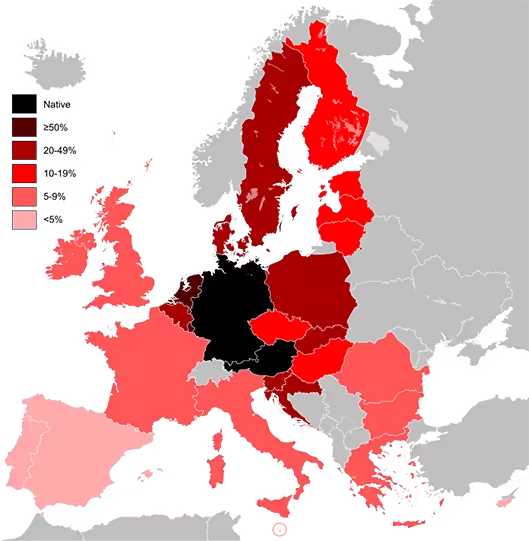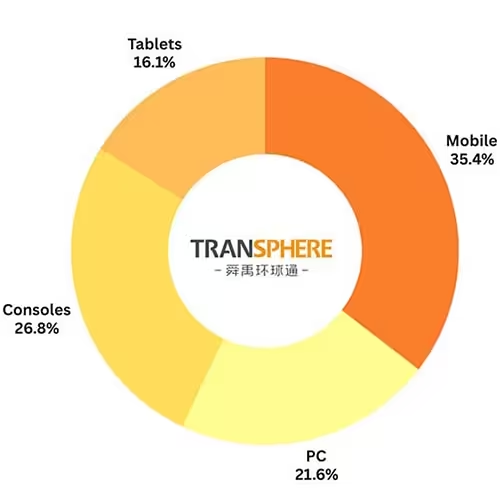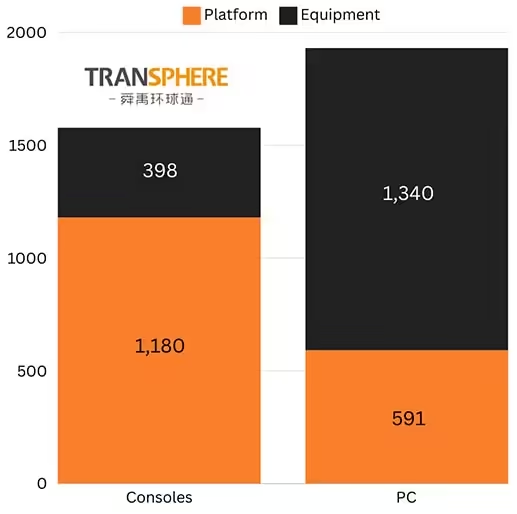The German language has always been important for game localization. As part of the FIGS languages (French, Italian, German, Spanish), it has consistently shown its value over the years.
Yet, the gaming world is changing. Languages like Chinese, Arabic, and Korean are growing in the market. So, we need to take a fresh look at what German brings to the table. To understand its true value today, we’ll explore several key questions:
- What qualifies as German, and how many people speak it?
- How many German-speaking gamers are there?
- How much can they spend on a game, and what is the value of the market as a whole?
- What challenges can you expect when translating your game into German.
The answers will help us see if German localization is still the smart choice it once was.
📃 This article is the second in a series exploring the major languages and their value for indie and AAA games alike. You can check out the first one about French here.
What is German?
German belongs to the Indo-European language family, specifically to the Germanic branch alongside the following:
- North Germanic: Norwegian, Danish, Swedish, etc.
- West Germanic: English, German, Dutch, etc.
- East Germanic: Now extinct languages like Gothic.
When we talk about German today, we need to distinguish between:
1. Standard German (Hochdeutsch)
It’s the standardized version of German used in formal settings, media, and education across German-speaking countries.
2. Regional variants:
- Germany’s everyday German (with its own regional dialects).
- Austrian German (Österreichisches Deutsch).
- Swiss German (Schweizer Hochdeutsch).
While people in German-speaking countries use their regional variants in daily life, they all learn Standard German in school. This is particularly important in Switzerland, where Swiss German is so different that it could be viewed as a separate language, making Swiss people effectively bilingual.
For this article, when we mention German, we’re specifically talking about Standard German, not its regional variants.
German is the most widely spoken Germanic language after English. In the European Union, it has the largest community of native speakers, ahead of French, Spanish, and Italian.
How many people speak German?
There are roughly 154 million German speakers worldwide, making it the 12th most spoken language globally.
But this number varies a lot based on how we they are counted. For example, the final count is much lower when focusing exclusively on natives. As such, we have to examine these two communities quickly.
Native speakers
According to World Data, 97.3 million people speak German as their first language in 20 countries. The largest segment comes from Germany, with 76.1 million natives.
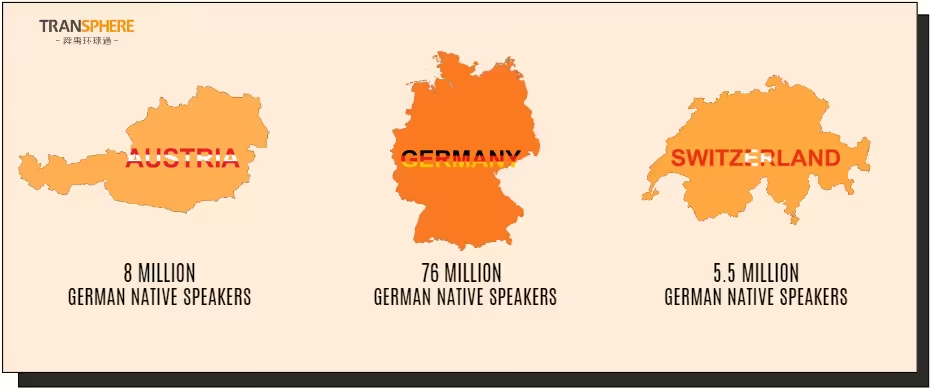
Non-native German speakers
There are roughly 56.8 million non-native German speakers worldwide. However, this number is more of an approximation than the number of native speakers.
In fact, estimates range from 80 million to as little as 52 million. We settled on using 56.8 million as our working number, representing an average of several sources. This helps avoid any single source’s potential bias.
How many German-speaking gamers are there?
German game localization gives you access to a potential pool of 87.5 million German-speaking players worldwide. Of these, about 58 million are natives, representing roughly 60% of all native German speakers. That’s a remarkably high ratio that suggests a strong gaming culture in German-speaking countries.
Most of these gamers are in Europe, with smaller communities spread across North America, South America, and Africa.
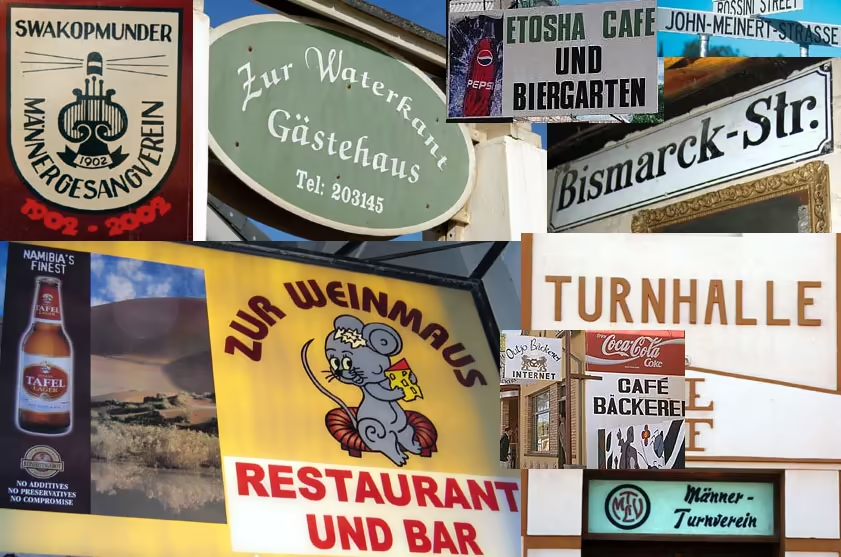
This concentration means that most of your German-speaking players will share similar time zones and gaming habits, so they can be targeted more easily than widely dispersed languages like Spanish.
Another 29.5 million gamers speak German as a second language. This is about 52% of all non-native German speakers, showing that gaming is popular among German language learners too.
With all of the above in mind, German is a language with a sizeable community. But that alone is not sufficiently precise to assess whether it’s valuable enough to include in your language portfolio.
To be sure of its value, we will dive into the most promising market of the many German-speaking countries—Germany.
What's the ideal market for German game localization?
Germany stands out as the primary target for German localization for two simple reasons: market size and spending power.
Germany alone has 45 million active gamers who spend money on games and in-game purchases. In 2023, this resulted in $5.07 billion in sales. Individually, each German gamer spends an average of $113—nearly double the global average of $59.
Let’s dive into their profiles.
The German gamer
German gamers have some unique characteristics that make them valuable customers:
Age and loyalty
The average German gamer is 38.2 years old, up from 33.6 in 2013. Many of these players started gaming young and stuck with it. This year alone, 300,000 more gamers entered the 60+ age group. This loyalty means that winning a German fan today could mean a customer for life.
Gender balance
The German gaming market is almost evenly split, with a slight majority being female gamers (52%). This balance means your game can reach a broad audience regardless of gender targeting.
Gaming platforms
German gamers use many different gaming devices. As such, there is a lot of overlap between different platforms. With that being said, current data shows the following breakdown:
- Smartphones: 23.5 million gamers
- Consoles: 17.8 million gamers
- PCs: 14.3 million gamers
- Tablets: 10.7 million gamers
The German market
Gamers aside, the German market offers substantial revenue potential for game developers. According to the German Games Industry Association, the market grew by 6% in 2023, generating almost $11 billion in revenue.
We can split the revenue source into two broad categories: hardware and software sales.
Hardware sales
In 2023, hardware sales reached around $3.5 billion, split between gaming computers, consoles, and their respective accessories. Consoles saw the most growth in this segment, with a 44% increase over the year, while PC sales remained stable.
Software sales
-
Game sales: Sales from PC and console games generated $1.18 billion in revenue in 2023, marking a 4% growth. Interestingly, mobile game sales didn’t contribute much here. That’s likely due to the dominance of the free-to-play model on mobile.
-
In-game purchases: Here, the picture flips, and mobile takes the lead, generating 60% of all in-game purchase revenue with a total of nearly $3.12 billion—a figure that continues to grow yearly. To put this in perspective, mobile in-game revenue has more than doubled since 2018, when it stood at around $1.61 billion. In-game purchases on other platforms added an extra $1.96 billion, bringing the total for this segment to $5.09 billion.
These numbers tell a compelling story: Germany’s gaming market combines high spending power ($113 per gamer), a massive player base (45 million active gamers), and steady market growth (6% in 2023).
Coupled with the diverse age range and balanced gender, Germany provides a mature and loyal market likely to remain stable for the decade ahead.
Yet, entering the German market is about more than just the promising numbers. German gamers are known for their high expectations when it comes to localized content, and the German language itself presents unique challenges for game developers.
The challenges of German game localization
Despite a common root, English and German are quite different. The latter has some fairly unique characteristics that often get in the way of the localization process.
Technical challenges
Space constraints
German is famous for its unique, lengthy compound words. While this may sound insignificant, it takes more screen space, leading to UI issues. Consider some common gaming instructions:
- “Damage over time effect” → “Zeitschadenseffekt.”
- “Character creation menu” → ” Charaktererstellung Menü.”
- “Inventory management” → “Inventarverwaltungs.”
- “Health regeneration potion” → “Gesundheitsregenerationstrank.”
Compound words aside, German is generally a “longer language” with lengthier strings. Consider the following examples:
- Menu items:
- “Settings” → “Einstellungen” (+5 characters).
- “Save Game” → “Spiel speichern” (+6 characters).
- Status effects:
- “Poisoned” → “Vergiftet” (+1 characters).
- “Out of mana” → “Keine Mana mehr” (+3 characters).
As you can see, German is typically 10-35% longer than English.
The German keyboard—QWERTZ
While not as different as the French keyboard layout (AZERTY), the German one has its set of unique differences.

These differences must be considered when mapping game controls to specific keys.
- “Ctrl” becomes “Strg” (Steuerungstaste) and should be documented accordingly. After all, it’s a very common key for a variety of commands like the quick-save feature (CTRL + S → Strg + C)
- On the right, the “Alt” key becomes “AltGr.”
- Z and Y are swapped compared to QWERTY.
- Brackets ([]) are removed to make space for an umlaut (ü). Specific combinations (AltGRr + 8/9) are needed to use them.
- The @ symbol requires the combination AltGr + Q.
Special characters
Linguistic challenges
The grammar
German game localization is challenging due to the language’s complex grammar and special characters. German articles and adjective endings vary depending on case, gender, and number. For example, the term “the sword” in the following sentences does not change in English:
- “The sword is sharp.”
- “The blade of the sword.”
- “He fights with the sword.”
But in German, the translation shifts each time:
- “The sword is sharp” → “Das Schwert ist scharf.”
- “The blade of the sword” → “Die Klinge des Schwertes.“
- “He fights with the sword” → “Er kämpft mit dem Schwert.“
You’ll also notice the term “sword” is capitalized. Unlike English, nouns are capitalized in German, whether proper nouns or not. In fact, German is the only major language that does so.
Pluralization rules
-
-(e)n
-
-e
-
-s
-
-er
-
no suffix at all
-
“1 coin” translates to “1 Münze,”
-
“2 coins” becomes “2 Münzen.”
Regulatory challenges
German game localization efforts must comply with stricter regulations than those of other languages. That’s due to Germany’s controversial history.
German constitutional restrictions, primarily through §86a StGB, prohibit using symbols from unconstitutional organizations. The law explicitly bans the display of Nazi imagery, including swastikas, SS runes, Nazi Party eagles, and related gestures or salutes.
These restrictions work alongside Youth Protection Laws (USK Requirements), which govern how historical content can be presented in interactive media.
Games depicting this era must carefully navigate these legal frameworks, often requiring substantial modifications to secure release approval.
German game localization in practice—Wolfenstein
Wolfenstein is a series of FPS games set in World War 2, in which the players fight the Axis powers in some form or another. As such, the German release had to include some major modifications for its second installment.
Axis uniforms were stripped of their insignias, and Swastika banners were replaced with fictional ones. Some specific terms were also changed. For example, the official name of the Nazi armies, “Wehrmacht,” was changed to “Regime” or “Forces.”
But, the most prominent modification was Hitler’s appearance. He was renamed “Heiler,” and his recognizable mustache was completely removed.
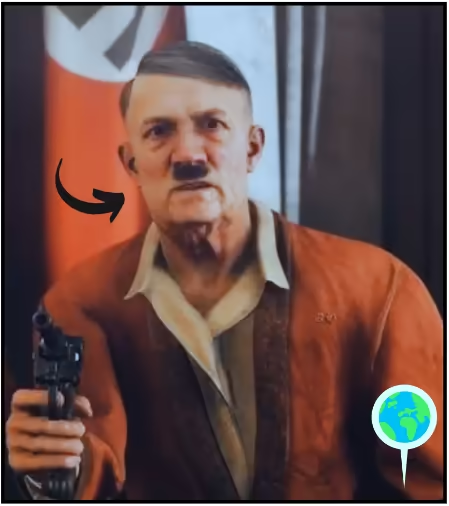
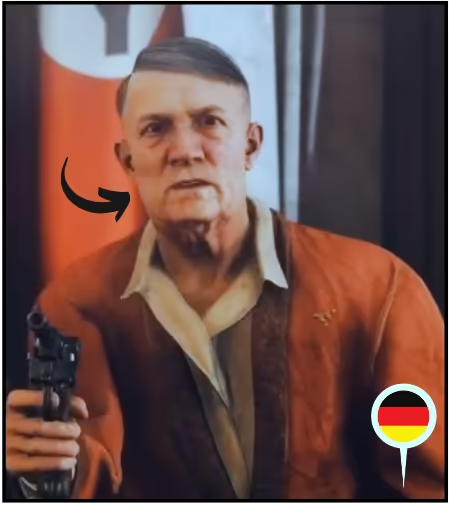
German game localization in practice—Hearts of Iron
A less famous example is Paradox Interactive’s Hearts of Iron series. The strategy game’s developers had to change the German leader’s portraits and all the controversial flags before the game’s release.

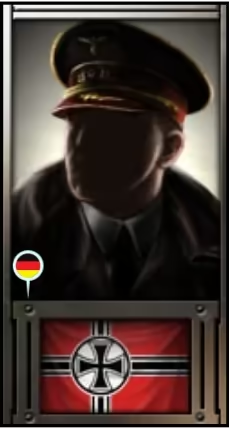
These restrictions mean developers must carefully plan their release and take their German game localization efforts more seriously.
Teams must establish separate asset pipelines for the German market, implement region-specific content swap mechanisms, and conduct additional QA testing cycles to ensure compliance. This often means maintaining parallel game versions with careful version control and separate USK submission processes.
Quality control
German’s unique characteristics make it a uniquely challenging language to translate effectively. As such, it is very important to build strict quality control processes to minimize the potential error rate.
The consequences of failing to do so can range from minor embarrassment to serious PR issues. A particularly striking example of this comes from Terraria, where a simple UI command translation went wrong in a way that could have been prevented with proper oversight.
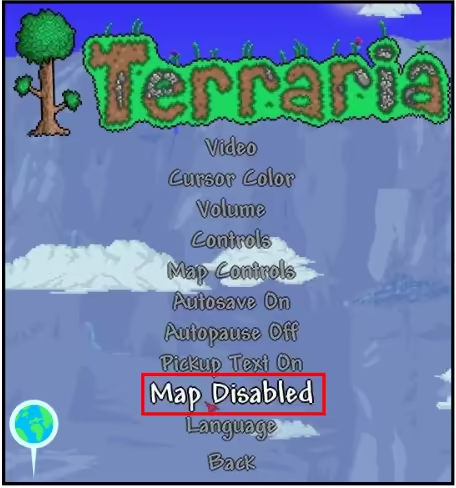
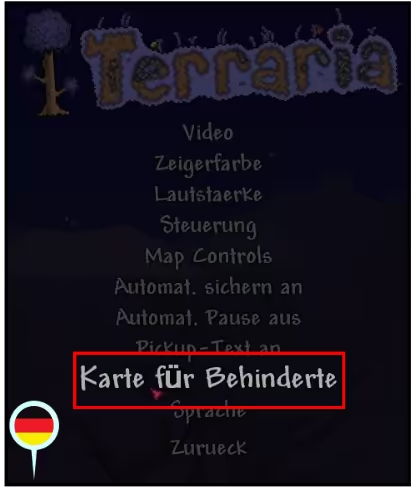
On the left, you can see the original version of the map (in English) with the command “Map disabled” highlighted. As its name indicates, this feature is designed to remove the map from the UI.
On the right, you can see the German translation of the menu. It was translated into “Karte für Behinderte,” which means “Map for Disabled People.” Not only is this a translation error, but it can seriously offend Terraria’s gaming community.
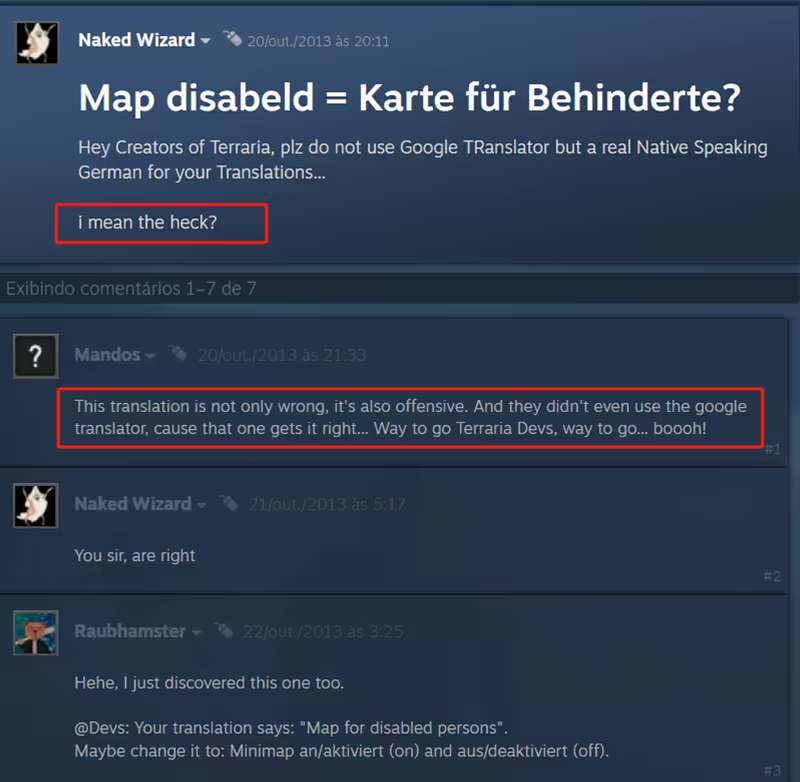
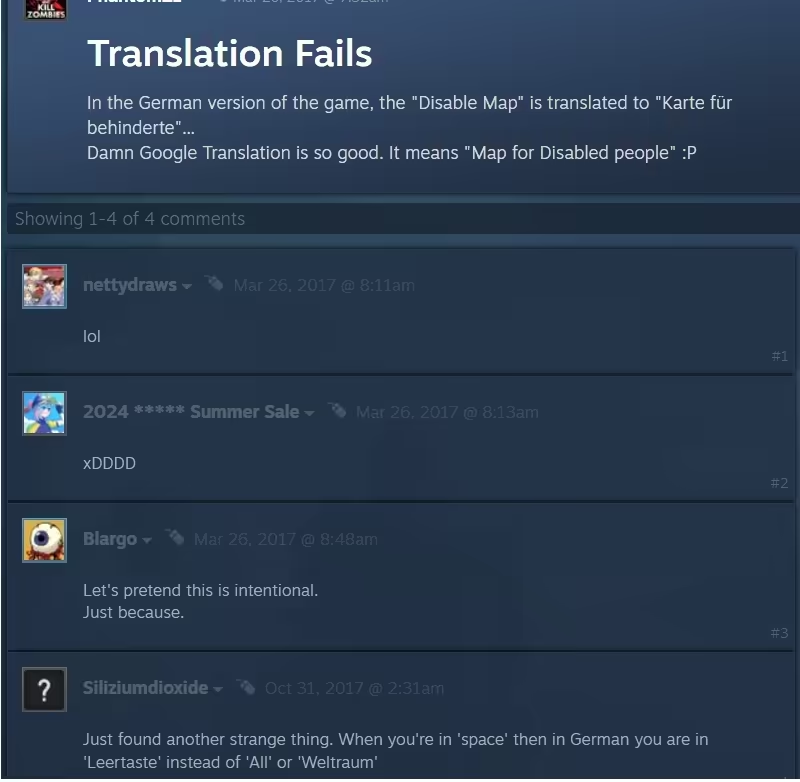
Cases like these show why we cannot emphasize enough the importance of implementing strict quality control processes overseen by translation professionals.

